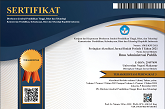Governance Collaborative Management for Handling Stunting in Bone District
(1) Faculty of Social and Political Sciences, Universitas Indonesia Timur, Indonesia
(2) Faculty of Social and Political Sciences, Universitas Indonesia Timur, Indonesia
(3) Faculty of Social and Political Sciences, Universitas Sembilanbelas November, Indonesia
(*) Corresponding Author
DOI: https://doi.org/10.26858/jiap.v13i2.52915
Abstract
To obtain superior Human Resources (HR) is still a challenge in various countries. Health and education are the focus of the main problems that hinder the achievement of superior human resources. Millions of young children are still not reaching their full potential due to a lack of nutrition, learning, and stimulation as well as exposure to stress. Bone Regency is one of the districts in South Sulawesi with a relatively high stunting rate. Bone Regency ranks 4th as a district with a high prevalence of stunting out of 24 districts in South Sulawesi after Jeneponto, Maros, Takalar. Bone Regency is one of the regencies that has been the location for stunting management interventions since 2019, considering that the stunting rate in Bone Regency is quite high. The purpose of this study was to analyze the intervention of the government, in this case stakeholders, non-governmental organizations, communities and the private sector, to collaborate to solve the problem of stunting in Bone district. One of the keys to effective collaborative governance requires governance structures and processes that facilitate coordination and decision-making across sectors. The data collection method was carried out through in-depth interviews and focus group discussions involving stakeholders at the provincial and district levels, to program implementers at the community level - sub-districts/community health centers (puskesmas) and villages/kelurahans. In-depth interviews with stakeholders at the provincial and district levels whose fields of work are related to programs/activities related to stunting prevention. So that the research results can describe the Electronic Based Government System (SPBE) in realizing active collaboration between stakeholders in the following years
Keywords
Full Text:
PDFReferences
Akuba, J., Lalu, N. A. S., & Nakoe, M. R. (2022). Gerakan Penurunan Stunting (GENTING) di Desa Ilomata, Kec. Bulango Ulu, Kab. Bone Bolango. Jurnal Pengabdian Masyarakat Farmasi: Pharmacare Society, 1(3), 76–84.
Aswi, A., & Sukarna, S. (2022). Pemodelan Spasial Bayesian dalam Menentukan Faktor yang Mempengaruhi Kejadian Stunting di Provinsi Sulawesi Selatan. JMathCoS: Journal of Mathematics, Computations, and Statistics, 5(1), 1–11.
Ayuningtyas, D., Hapsari, D., Rachmalina, R., Amir, V., Rachmawati, R., & Kusuma, D. (2022). Geographic and socioeconomic disparity in child undernutrition across 514 districts in Indonesia. Nutrients, 14(4), 843.
Höhna, S., Landis, M. J., Heath, T. A., Boussau, B., Lartillot, N., Moore, B. R., Huelsenbeck, J. P., & Ronquist, F. (2016). RevBayes: Bayesian phylogenetic inference using graphical models and an interactive model-specification language. Systematic Biology, 65(4), 726–736.
Jackson, D., Barrett, J. K., Rice, S., White, I. R., & Higgins, J. P. T. (2014). A design‐by‐treatment interaction model for network meta‐analysis with random inconsistency effects. Statistics in Medicine, 33(21), 3639–3654.
Karim, A., Ruslan, M., Burhanuddin, A., Taibe, P., & Sobirin, S. (2023). Contribution of Village Funds to Regional Economic Recovery in South Sulawesi Province. SEIKO: Journal of Management & Business, 6(1), 573–589.
Kismul, H., Acharya, P., Mapatano, M. A., & Hatløy, A. (2018). Determinants of childhood stunting in the Democratic Republic of Congo: further analysis of Demographic and Health Survey 2013–14. BMC Public Health, 18(1), 1–14.
Marbun, M. B. H., Susalit, E., & Umami, V. (2018). years experience of living donor kidney transplantation in Indonesia: a retrospective cohort study. Acta Med Indones, 50(2), 119–124.
Mengistu, K., Alemu, K., & Destaw, B. (2013). Prevalence of malnutrition and associated factors among children aged 6-59 months at Hidabu Abote District, North Shewa, Oromia Regional State. J Nutr Disorders Ther, 1(1), 2161–2509.
Muhafidin, D. (2022). Policy strategies to reduce the social impact of stunting during the COVID-19 pandemic in Indonesia. Journal of Social Studies Education Research, 13(2), 320–342.
Osazuwa, F., Ayo, O. M., & Imade, P. (2011). A significant association between intestinal helminth infection and anaemia burden in children in rural communities of Edo state, Nigeria. North American Journal of Medical Sciences, 3(1), 30.
Postmes, T., Haslam, S. A., & Swaab, R. I. (2005). Social influence in small groups: An interactive model of social identity formation. European Review of Social Psychology, 16(1), 1–42.
Pramana, S., & Mariyah, S. (2021). Big data implementation for price statistics in Indonesia: Past, current, and future developments. Statistical Journal of the IAOS, 37(1), 415–427.
Santika, N. K. A., Efendi, F., Rachmawati, P. D., Has, E. M. M., Kusnanto, K., & Astutik, E. (2020). Determinants of diarrhea among children under two years old in Indonesia. Children and Youth Services Review, 111, 104838.
Wijayanti, F., Yudha, R., & Saparita, R. (2023). Inovasi Sosial pada Penanganan Stunting: Penerapan Konsep Bapak Asuh Anak Stunting di Tambak Dahan, Subang, Provinsi Jawa Barat. Sosio Konsepsia: Jurnal Penelitian Dan Pengembangan Kesejahteraan Sosial, 12(2).
Yusriadi, Y., & Cahaya, A. (2022). Food security systems in rural communities: A qualitative study. Frontiers in Sustainable Food Systems, 6, 987853.
Article Metrics
Abstract view : 188 times | PDF view : 3 timesRefbacks
- There are currently no refbacks.
Copyright (c) 2023 Sudiarti Dewi Kurra, Henni Zainal, Dewi Sulfa Saguni

This work is licensed under a Creative Commons Attribution 4.0 International License.
Diterbitkan oleh:
Program Studi Ilmu Administrasi Publik
Program Pascasarjana Universitas Negeri Makassar
JIAP Index By:

This work is licensed under a Creative Commons Attribution 4.0 International License.









